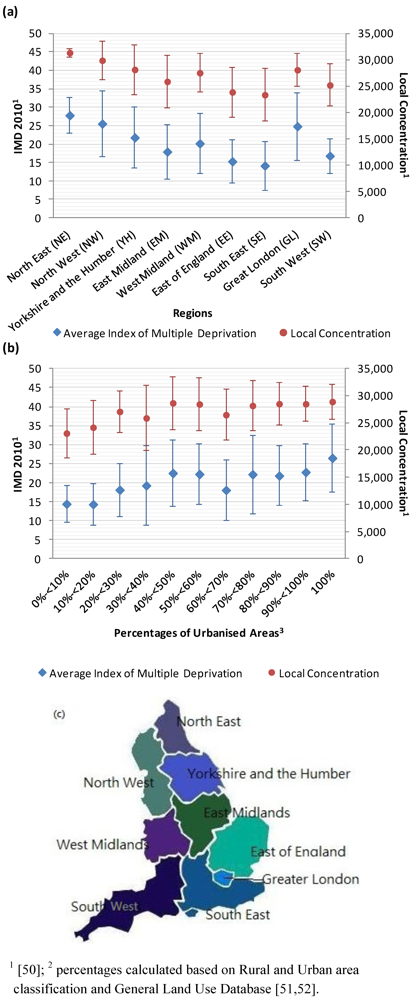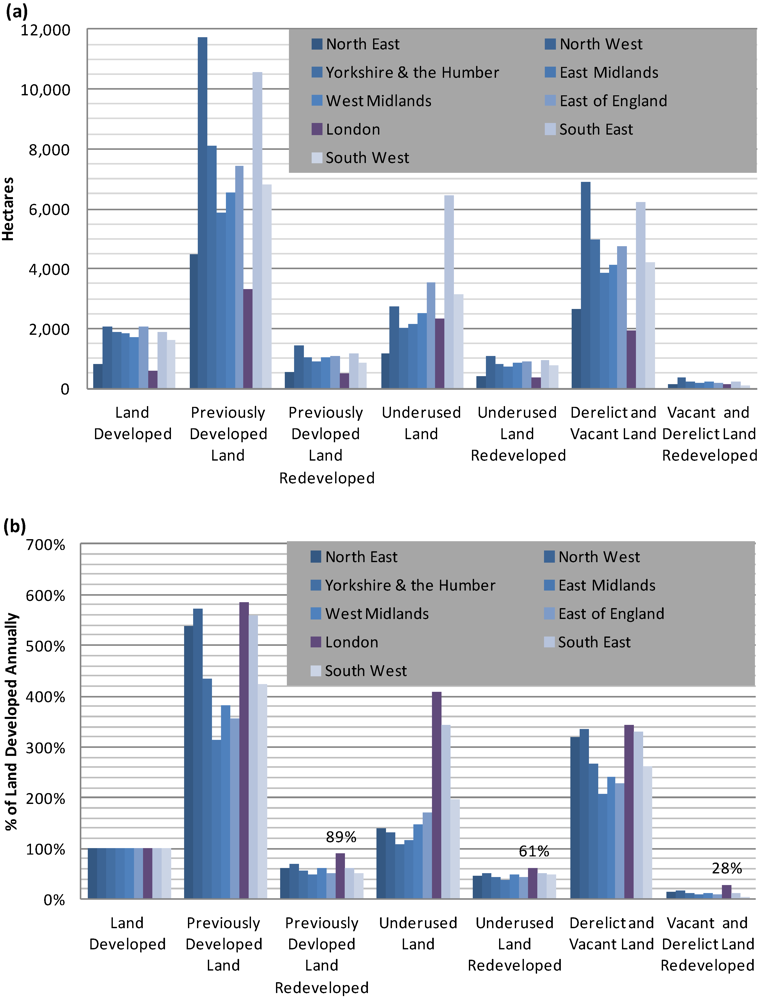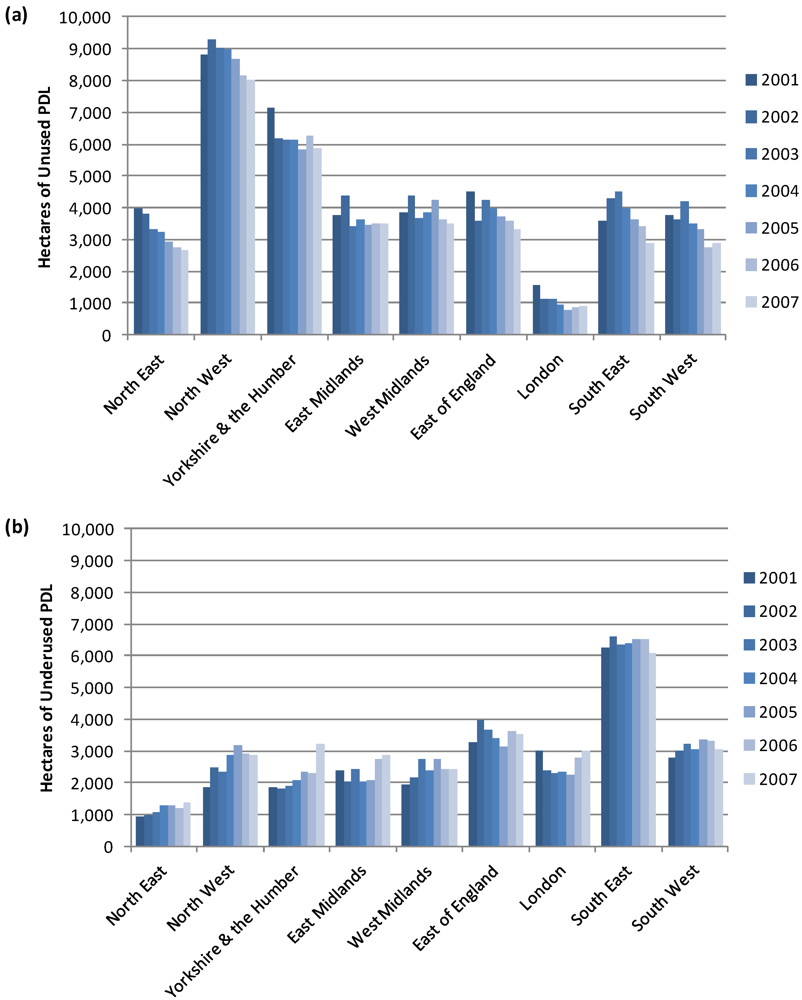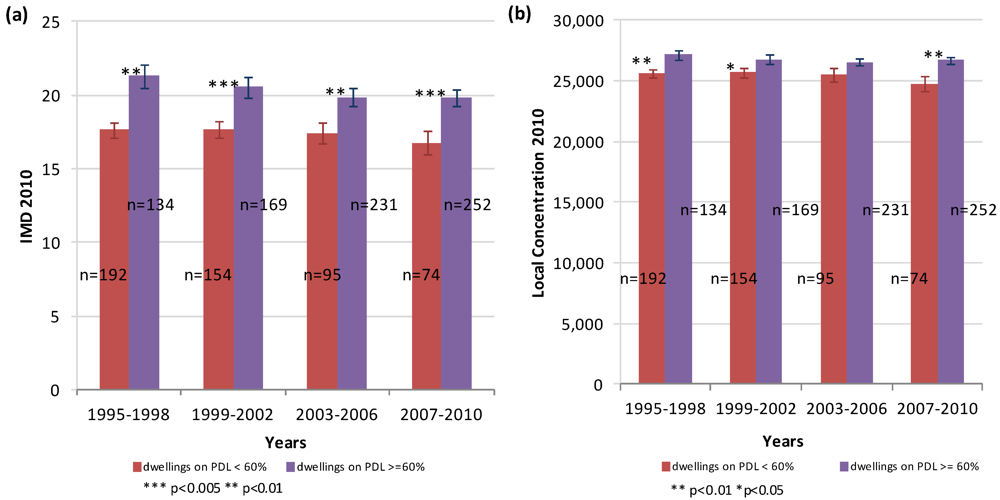Sticks and Stones: The Impact of the Definitions of Brownfield in Policies on Socio-Economic Sustainability
Abstract
:1. Introduction
1.1. The Origins of Brownfield Land
1.2. Strategies Towards Brownfield Regeneration
1.3. The Effects of Regional Differences and Urbanisation on Brownfield Land and Socio-Economic Conditions
1.4. The Controversy of Brownfield Redevelopment
2. Data and Statistical Analyses
2.1. National Land Use Database of Previously Developed Land (NLUD-PDL)
- (A) Previously developed land which is now vacant;
- (B) Vacant buildings;
- (C) Derelict land and buildings;
- (D) Land or buildings currently in use and allocated in the local plan and/or having planning permission;
- (E) Land or buildings currently in use where it is known there is potential for redevelopment; and
- (F) Previously developed land or buildings that have been developed or where construction has started.
| NLUD-PDL Category 1 | Previously Developed | ||
|---|---|---|---|
| Unused Land | Underused Land | ||
| Derelict 2 Land | Vacant 3 Land | ||
| A | ✗ | ✓ | ✗ |
| B | ✗ | ✓ | ✗ |
| C | ✓ | ✗ | ✗ |
| D | ✗ | ✗ | ✓ |
| E | ✗ | ✗ | ✓ |
2.2. Indices of Multiple Deprivation (IMD) 2010
| Deprivation Domain | Sub-domains | Weight in the Indices | Components in the Domains |
|---|---|---|---|
| Income | - | 22.50% | Income Support Households, Job Seekers Allowance Households, Pension Credit (Guarantee) Households, Working Tax Credit Households, Child Tax Credit Households, National Asylum Support Service (NASS) Supported Asylum Seekers |
| Employment | - | 22.50% | Recipients of Jobseekers Allowance, Participants in the New Deal, Incapacity Benefit Recipients, Severe Disablement Allowance Recipients |
| Health and Disability | - | 13.50% | Years of Potential Life Lost, Comparative Illness and Disability Ratio, Measures of Acute Morbidity, The Proportion of Adults under 60 Suffering from Mood or Anxiety Disorders |
| Education, Skills and Training | Children | 6.75% | Average Test Score of Pupils at Key Stage 2 and Stage 3, Best of 8 Average Capped Point Score at Key Stage 4, Proportion of Young People not Staying on in School or Non-Advanced Education, Secondary School Absence Rate, Proportion of those Aged under 21 Not Entering Higher Education |
| Skills | 6.75% | Proportion of Working Age Adults with No or Low Qualifications | |
| Barriers to Housing and Services | Wider barriers | 4.65% | Household Overcrowding, District Level Rate of Acceptances under the Homelessness Provisions, Difficulty of Access to Owner-Occupation |
| Geographical barriers | 4.65% | Road Distances to a GP Surgery, a General Store or Supermarket a Primary School a Post Office or Sub Post Office | |
| Crime | - | 9.30% | Burglary, Theft, Criminal Damage, Violence |
| Living Environment | “Indoors” living environment | 6.20% | Social and Private Housing in Poor Condition, Houses without Central Heating |
| “Outdoors” living environment | 3.10% | Air Quality, Road Traffic Accidents Involving Injury to Pedestrians and Cyclists |
2.3. The Estimation of Urbanisation
2.4. The Determination of Regions
2.5. The Development of PDL and Non-PDL
2.6. ANOVA Analysis
2.7. Independent-Sample t-Tests
3. Results
3.1. The Effects of PDL on Socio-Economic Deprivation Scores

| Independent Variables and Co-variants | Dependent Variables | |||||||
|---|---|---|---|---|---|---|---|---|
| IMD Average | Local Concentration | |||||||
| Region | Urbanisation | PDL | Region | Urbanisation | PDL | |||
| Effect of Independent Variables on Dependent Variables | Total PDL | ++++ (F(8,295) = 12.47) | ++++ (F(10,295) = 4.04) | ++++ (F(1,295) = 16.90) | ++++ (F(8,295) = 10.74) | - | ++++ (F(1,295) = 22.32) | |
| Total PDL | Underused | ++++ (F(8,295) = 14.25) | ++++ (F(10,295) = 7.97) | - | ++++ (F(8,295) = 12.58) | ++++ (F(10,295) = 6.16) | - | |
| Unused | ++++ (F(8,295) = 9.66) | ++++ (F(10,295) = 9.29) | ++++ (F(1,295) = 22.92) | ++++ (F(8,295) = 8.19) | ++++ (F(10,295) = 7.09) | ++++ (F(1,295) = 22.37) | ||
| Unused Land | Vacant (less than a year) | ++++ (F(8,295) = 10.20) | ++++ (F(10,295) = 9.24) | ++++ (F(1,295) = 24.77) | ++++ (F(8,295) = 9.05) | ++++ (F(10,295) = 7.24) | ++++ (F(1,295) = 19.34) | |
| Derelict (more than a year) | ++++ (F(8,295) = 9.36) | ++++ (F(10,295) = 11.52) | ++++ (F(1,295) = 17.37) | ++++ (F(8,295) = 7.60) | ++++ (F(10,295) = 9.07) | ++++ (F(1,295) = 17.27) | ||
3.2. Amount of PDL and Land Needed for Redevelopment



3.3. The Effect of the Density of Residential Development on PDL on the Conditions of Deprivation

4. Discussions
4.1. The Effects of Regions, Urbanisation and PDL on Socio-Economic Deprivation
4.2. PDL Definition in the Policy Should Prevent Further Benefitting “Cherry Picking”
4.3. The Regeneration Policy Should Target the Issues Relevant to Deprivation.
4.4. The Regeneration Policy Should Reduce Further Greenfield Development
4.5. A More Specific Definition and Mixed-Use Development Target
5. Conclusions
Acknowledgments
Conflict of Interest
References
- DETR, A Better Quality of Life; DETR: London, UK, 1999.
- Small Business Liability Relief and Brownfields Revitalization Act, USA, 2001; (section 211(a)(39)(A)).
- Grimski, D.; Ferber, U. Urban Brownfield in Europe. Land Contam. Reclam. 2001, 9, 143–148. [Google Scholar]
- Syms, P. Releasing Brownfields; Joesph Rowntree Foundation: York, UK, 2001. [Google Scholar]
- Klapperich, H. Interdisciplinary Approach for Brownfields. In Brownfield Sites: Assessment, Rehabilitation and Development; Brebbia, C.A., Almorza, D., Klapperich, H., Eds.; WIT Press: Southampton, UK, 2002; pp. 1–13. [Google Scholar]
- Syms, P. Involving communities in the effective and efficient reuse of contaminated and derelict land in England. J. Urban Regen. Renew. 2010, 3, 301–314. [Google Scholar]
- Alker, S.; Joy, V.; Roberts, P.; Smith, N. The definition of Brownfield. J. Environ. Plan. Manag. 2000, 1, 49–69. [Google Scholar]
- Oliver, L.; Ferber, U.; Grimski, D.; Millar, K.; Nathanail, C.P. The Scale and Nature of European Brownfields. In Proceedings of the CABERNET 2005: The International Conference on Management Urban Land, Belfast, UK, 13–15 April 2005; Oliver, L., Millar, K., Grimski, D., Ferber, U., Nathanail, C.P., Eds.; Land Quality Press: Nottingham, UK, 2005; pp. 238–244. [Google Scholar]
- Ganser, R.; Williams, K. Brownfield development: Are we using the right targets? Evidence from England and Germany. Eur. Plan. Stud. 2007, 15, 603–622. [Google Scholar]
- Adams, D.; de Sousa, C.; Tiesdell, S. Brownfield development: A comparison of North American and British approaches. Urban Stud. 2010, 47, 75–104. [Google Scholar]
- CLG, Planning Policy and Statement 3 (PPS3) Housing; Department for Communities and Local Government: London, UK, 2006.
- Mieszkowski, P.; Mills, E.S. The causes of metropolitan suburbanization. J. Econ. Perspect. 1993, 7, 135–147. [Google Scholar]
- Accordino, J.; Johnson, G.T. Addressing the vacant and abandoned property problem. J. Urban Aff. 2000, 22, 301–315. [Google Scholar]
- Spelman, W. Abandoned buildings: Magnets for crime? J. Crim. Justice 1993, 21, 481–495. [Google Scholar] [CrossRef]
- Walkowiak, E.; Frazier, D. Brownfield Redevelopment as a Catalyst for Creating Sustainable Cities. In Sustainable City: Urban Regeneration and Sustainability; Brebbia, C.A., Ferrante, A., Rodriguez, M., Terra, B., Eds.; WIT Press: Rio Janeiro, Brazil, 2000; Volume 9, pp. 113–122. [Google Scholar]
- Webster, D. The geographical concentration of labour-market disadvantage. Oxford Rev. Econ. Pol. 2000, 16, 114–128. [Google Scholar]
- Brown, B.B.; Perkins, D.D.; Brown, G. Crime, new housing, and housing incivilities in a first-ring suburb: Multilevel relationships across time. Hous. Policy Debate 2004, 15, 301–345. [Google Scholar] [CrossRef]
- Stewart, D. “Smart Development” for Brownfields: A Futures Approach Using the Prospective through Scenario Planning Method. In Brownfield Sites II: Assessment, Rehabilitation and Development; Donati, A., Rossi, C., Brebbia, C.A., Eds.; WIT Press: Southampton, UK, 2004; pp. 233–241. [Google Scholar]
- Gibson, K.J. Bleeding albina: A History of community disinvestment 1940–2000. Transform. Anthropol. 2007, 15, 3–25. [Google Scholar]
- Lange, D.; McNeil, S. Clean it and they will come? Defining successful Brownfield development. J. Urban Plan. D-ASCE 2004, 130, 101–108. [Google Scholar] [CrossRef]
- NRTEE, Cleaning up the Past, Building the Future: A National Brownfield Redevelopment Strategy for Canada; National Round Table on the Environment and the Economy: Ottawa, ON, Canada, 2003.
- Auckland City Council, Submission on the Proposed National Environmental Standard for Assessing and Managing Contaminants in Soil; Auckland City Council: Auckland City, New Zealand, 2010.
- CLG, Planning Policy Statement 3 (PPS3) Housing; Department for Communities and Local Government, London, UK, 2010.
- Bibby, P. Land use change in Britain. Land Use Policy 2009, 26, S2–S13. [Google Scholar]
- CLG. Live Tables of Land Use Change Statistics. 29 July 2011. Available online: http://www.communities.gov.uk/planningandbuilding/planningbuilding/planningstatistics/livetables/landusechange/ (accessed 10 January 2012).
- Wong, C.; Schulze-Baing, A. Brownfield Residential Redevelopment in England: What Happens to the Most Deprived Neighbourhoods? The Joseph Rowntree Foundation: York, UK, 2010. [Google Scholar]
- Lees, L.; Slater, T.; Wyly, E. Gentrification: Positive or Negative? In Gentrification; Lees, L., Slater, T., Wyly, E., Eds.; Routledge: New York, NY, USA, 2008; pp. 195–236. [Google Scholar]
- Apostolidis, N.; Hutton, N. Integrated water management in Brownfield sites—More opportunities than you think. Integr. Concepts Water Recycl. 2006, 188, 167–175. [Google Scholar]
- CABERNET, Sustainable Brownfield Regeneration: CABERNET Network Report; University of Nottingham: Nottingham, UK, 2006.
- Dixon, T. The property development industry and sustainable urban brownfield regeneration in England: An analysis of case studies in Thames Gateway and Greater Manchester. Urban Stud. 2007, 44, 2379–2400. [Google Scholar]
- Elliott, J.R.; Frickel, S. Environmental dimensions of urban change: uncovering relict industrial waste sites and subsequent land use conversions in Portland and New Orleans. J. Urban Aff. 2011, 33, 61–82. [Google Scholar]
- Rall, E.L.; Haase, D. Creative intervention in a dynamic city: A sustainability assessment of an interim use strategy for Brownfield in Leipzig, Germany. Landsc. Urban Plan. 2011, 100, 189–201. [Google Scholar]
- Smith, N. Toward a theory of gentrification a back to the city movement by capital, not people. J. Am. Plan. Assoc. 1979, 45, 538–548. [Google Scholar]
- de Sousa, C. Brownfield redevelopment versus greenfield development: a private sector perspective on the costs and risks associated with brownfield redevelopment in the Greater Toronto Area. J. Environ. Plan. Manag. 2000, 43, 831–853. [Google Scholar]
- McCarthy, L. The Brownfield dual land-use policy challenge: Reducing barriers to private redevelopment while connecting reuse to broader community goals. Land Use Policy 2002, 19, 287–296. [Google Scholar]
- Nijkamp, P.; Rodenburg, C.A.; Wagtendonk, A.J. Success factor for sustainable urban Brownfield development: A comparative case study approach to polluted sites. Ecol. Econ. 2002, 40, 235–252. [Google Scholar]
- Stead, D.; Hoppenbrouwer, E. Promoting an urban renaissance in England and Netherlands. Cities 2004, 21, 119–136. [Google Scholar]
- The World Bank, The Management of Brownfields Redevelopment: A Guidance Note; The World Bank: Washington, DC, USA, 2010.
- Martin, R. The political economy of Britain’s North-South Divide. Trans. Inst. Br. Geogr. New Ser. 1988, 13, 389–418. [Google Scholar]
- Keeble, D.; Bryson, J. Small-firm creation and growth, regional development and the North-South Divide in Britain. Environ. Plan. A. 1996, 28, 909–934. [Google Scholar]
- Green, A.E. The North-South Divide in Great Britain: An examination of the evidence. Trans. Inst. Br. Geogr. New Ser. 1988, 13, 179–198. [Google Scholar]
- Longo, A.; Campbell, D. What are the Determinants of Brownfields Regeneration? An Analysis of Brownfields in England. In Proceedings of the Conference on the Science and Education of Land Use: A Transatlantic, Multidisciplinary and Comparative Approach, Washington, DC, USA, 24–26 September 2007.
- CLG, The English Indices of Deprivation 2007; Department for Communities and Local Government: London, UK, 2008.
- Smith, N. New globalism, new urbanism: Gentrification as global urban strategy. Antipode 2002, 34, 427–450. [Google Scholar]
- de Sousa, C.A. Brownfield redevelopment in Toronto: An examination of past trends and future prospects. Land Use Policy 2002, 19, 297–309. [Google Scholar]
- de Sousa, C.A. The greening of Brownfields in American cities. J. Environ. Plan. Manag. 2004, 47, 579–600. [Google Scholar]
- ODPM, Previously-Developed Land that May be Available for Development: England 2004; Office of the Deputy Prime Minister: London, UK, 2005.
- CLG, The English Indices of Deprivation 2010; Department for Communities and Local Government: London, UK, 2011.
- CLG, Previously-Developed Land that May be Available for Development: England 2006; Department for Communities and Local Government: London, UK, 2007.
- ONS. Generalised Land Use Database, 2005. Available online: http://www.neighbourhood.statistics.gov.uk/dissemination/Download1.do (accessed 23 May 2011).
- ONS. Rural/Urban Definition (England and Wales). Available online: http://www.ons.gov.uk/about-statistics/geography/products/area-classifications/rural-urban-definition-and-la-classification/rural-urban-definition/index.html (accessed 23 May 2011).
- Keenan, P.; Lowe, S.; Spencer, S. Housing abandonment in inner cities—The politics of low demand for housing. Hous. Stud. 1999, 14, 703–716. [Google Scholar]
- Kolivas, G. JESSICA: Developing new european instruments for sustainable urban development. Inf. Raumentwicklung 2007, 9, 563–571. [Google Scholar]
- Kreuz, C.; Nadler, M. JESSICA-UDF Typologies and Governance Structures in the Context of Jessica Implementation; European Investment Bank: Luxembourg, 2010. [Google Scholar]
- Ganser, R. Assessing Sustainability in Urban Planning: The Potential and Limitations of Indicators as a Means to Measure and Monitor Outcomes of Policy Implementation. In Local Sustainable Urban Development in a Globalized World; Heberle, L.C., Opp, S.M., Eds.; Ashgate Publishing Limited: Hampshire, UK, 2008; pp. 111–130. [Google Scholar]
- Mallett, H. The National Planning Policy Framework (NPPF)—What Role for Technical Guidance? In Oral presentation in the seminar “Where Now for Land Regeneration?— Implications of the Proposed Changes in Planning Policy and Effective Regulation of Land Contamination”, Nottingham, UK, 10 November 2011.
- Kells, G. The Essential Role of Brownfield Regeneration. In Proceedings of the Conference “Lessons in Land Regeneration”, Keyworth, UK, 29 November 2011.
- Tang, Y.T. Investigating Sustainable Land Use: Possible Implications for Brownfield Regeneration Policy. Ph.D Thesis, The University of Nottingham, Nottingham, UK, 2011. [Google Scholar]
© 2012 by the authors; licensee MDPI, Basel, Switzerland. This article is an open-access article distributed under the terms and conditions of the Creative Commons Attribution license (http://creativecommons.org/licenses/by/3.0/).
Share and Cite
Tang, Y.-T.; Nathanail, C.P. Sticks and Stones: The Impact of the Definitions of Brownfield in Policies on Socio-Economic Sustainability. Sustainability 2012, 4, 840-862. https://doi.org/10.3390/su4050840
Tang Y-T, Nathanail CP. Sticks and Stones: The Impact of the Definitions of Brownfield in Policies on Socio-Economic Sustainability. Sustainability. 2012; 4(5):840-862. https://doi.org/10.3390/su4050840
Chicago/Turabian StyleTang, Yu-Ting, and C. Paul Nathanail. 2012. "Sticks and Stones: The Impact of the Definitions of Brownfield in Policies on Socio-Economic Sustainability" Sustainability 4, no. 5: 840-862. https://doi.org/10.3390/su4050840
APA StyleTang, Y.-T., & Nathanail, C. P. (2012). Sticks and Stones: The Impact of the Definitions of Brownfield in Policies on Socio-Economic Sustainability. Sustainability, 4(5), 840-862. https://doi.org/10.3390/su4050840




